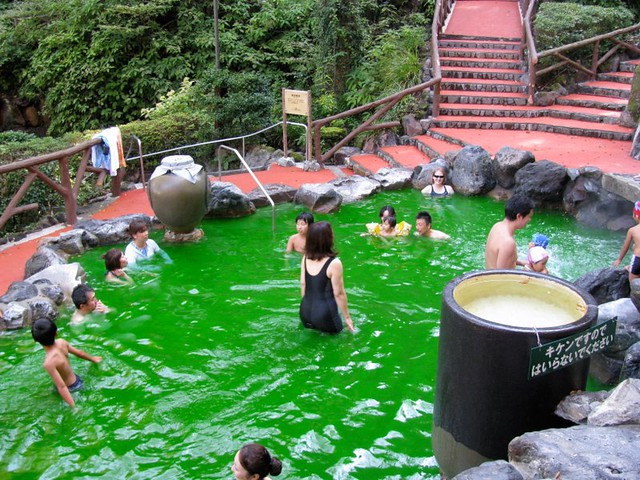Hakone (箱根) is one of the most famous onsen resort towns in Japan. Its stature grew from the Edo Period, when it served as a post town and checkpoint along the Tokaido trail between Kyoto and Edo (later Tokyo). Situated only 90 kilometres (55 miles) southwest of Tokyo, Hakone makes up part of the Fuji-Hakone-Izu National Park. Beyond bathing, Hakone offers a wealth of museums and unique natural settings, from the volcanic valley Owakudani to the wide Lake Ashi, from which one can view Mount Fuji. A popular sightseeing itinerary is to take a round-course trip utilising the region's various trains, cable-cars, boats, and buses.
Main Attractions

|
| By horschmology [CC BY 2.0], via Flickr |

|
| leon&mae / CC BY |

|
| 掬茶 / CC BY-SA |
5) Hakone Museum of Art: A collection of Asian and international artifacts, with a landscape garden.
6) Hakone Glass Forest: A museum park devoted to Venetian glass and other Italian trappings.

|
| JiroS. / CC BY-SA |
.jpg/640px-Hakone%2C_hot_springs_(6215256412).jpg)
|
| Arian Zwegers / CC BY |

|
| Quercus acuta / CC0 |

|
| Gin The Wanderer / CC BY |

|
| xezna / CC BY-SA |
12) Hakone Checkpoint Museum: A reconstruction of a checkpoint along the old Tokaido road.

|
|
The Ancient Cedar Road, a section of the Old Tokaido between
Hakone-machi and Moto-Hakone. Daderot / CC0 |

|
| Σ64 / CC BY |
Orientation
The major sites of Hakone are spread-out, and are connected by two bus networks. The first is owned by Hakone-Tozan, a subsidiary of Odakyu Railway. Their buses are covered by the Hakone Free Pass, which also covers the Hakone-Tozan Railway, the Gora Cable Car, the Hakone Ropeway, and Hakone Sightseeing Cruise boats. It costs ¥4,600 for two consecutive days, or ¥5,000 for three days, when purchased from ticket machines within the coverage zone (starting from Odawara Station). More information: (English)
To search for routes between spots in Hakone, using Hakone Free Pass-compatible transportation, visit the website "Hakone Transit Search" (English) (Japanese).
One popular route for getting around Hakone is the "Hakone Round Course", which goes as follows:
- Hakone-Tozan Railway from Odawara to Hakone-Yumoto Station (15 minutes, 3-5 per hour, ¥320)
- Hakone-Tozan Railway, from Hakone-Yumoto to Gora Station (35 minutes, 4-5 per hour, ¥410)
- Gora Cable Car, from Gora to Sounzan Station (10 minutes, 3-4 per hour, ¥430)
- Hakone Ropeway, from Gora to Togendai Station (30 minutes, 1 per minute, ¥1,480)
- Hakone Sightseeing Cruise, from Togendai to Hakone-Machi Port (30 minutes, 1-2 per hour, ¥1,050)
- Bus from Hakone-Machi to Odawara Station (45-75 minutes, 2-6 per hour, ¥1,200)
The Hakone Free Pass can save ¥290 when following this itinerary, not
including any discounts presented by most sites when showing the pass at
admission. Of course, there are plenty of changes one can make to this
plan, such as replacing certain legs with bus rides along other routes, or
stopping overnight at a hotel along the way.
A second network of buses is run by the Izu-Hakone Railway. The Hakone Free Pass is not valid on any Izu-Hakone-affiliated transportation, but they sell their own free-pass, the "Hakone Tabidasuke" (箱根旅助け). It covers Izu-Hakone buses, the Komagatake Ropeway, and Izuhakone Sightseeing Boats. It costs ¥3,000 for two consecutive days. Passes covering only Izu-Hakone buses for one or two days are also available, costing ¥1,700 and ¥2,000 respectively. More information: (English) (Japanese)
To search for routes using Izu-Hakone buses, there is a Japanese-only website available: (Japanese)
Access
The most direct train route to Hakone is by the Odakyu network. From Shinjuku Station, take the Odakyu Odawara line to Odawara (90 minutes, ¥900), and transfer on the Hakone-Tozan line to Hakone-Yumoto (15 minutes, ¥320). "Romancecar" limited-express trains make the journey from Shinjuku to Hakone-Yumoto without any transfers; they cost up to an additional ¥1,100 on top of the base fare. From there, you can continue on the upper portion of the Hakone-Tozan line (transfer required), or take a bus.
Odakyu sells a version of the Hakone Free Pass which includes round-trip train fare from Tokyo. This pass costs ¥5,700 for two days, or ¥6,100 for three days, and can be purchased at stations along the Odakyu line before Odawara. It does not cover supplement fare for "Romancecar" limited-express services.
For Japan Rail Pass holders, the fastest route is to take the Tokaido Shinkansen from Tokyo or Shinagawa Stations to Odawara (Kodama/Hikari, 30-35 minutes, ¥3,810 reserved, JR Pass OK), and switch to the Hakone-Tozan line from there. Taking the regular Tokaido Main Line between Tokyo and Odawara takes 90 minutes and costs ¥1,520. The Japan Rail Pass does not cover the Hakone-Tozan line.







